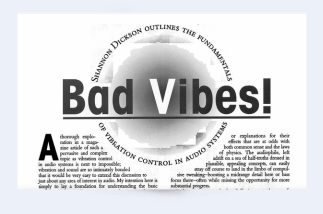Bad Vibes: Shannon Dixon outlines fundamentals of vibration control
Revisiting Shannon Dixon’s Seminal 1995 Article: Bad Vibes ‘The Fundamentals of Vibration Control in Audio’ in Stereophile Magazine 1995, audio journalist Shannon Dixon published a groundbreaking article that explored the fundamentals of vibration control in audio systems, a topic that remains central to achieving superior sound quality (SQ). At the time, Townshend Audio provided Dixon with a last-minute product for inclusion: our pneumatic Seismic Sink, a device that would redefine the audiophile landscape in the U.K. Dixon’s article sang its praises, highlighting the critical distinction between attenuation and true isolation through decoupling. Nearly three decades later, his insights continue to resonate, and our evolved air-damped spring systems—successors to the original Seismic Sink—have cemented Townshend Audio’s leadership in vibration control. We revisit Dixon’s article, weaving in its key findings with our journey from pneumatic isolation to today’s cutting-edge solutions,
The Fundamentals of Vibration article laid bare the impact of vibrations on audio playback, a challenge that audiophiles still grapple with today. Vibrations, ranging from tangible tremors to sub-micron disturbances at subsonic frequencies, introduce distortions in both time and frequency domains. These disruptions, intricately tied to phase linearity and mechanical resonance, limit a system’s SQ—encompassing tonal balance, clarity, soundstage, transient response, and low distortion. As Dixon noted, improving one aspect, such as vibration isolation or phase accuracy, can enhance the other, unlocking significant gains in transient performance. However, he cautioned that many audiophiles mistake tonal tweaks for genuine resolution improvements, a pitfall that remains relevant.Attenuation devices, such as damping pucks, sand-filled bases, or polymeric materials like Sorbothane, were common in the 1990s and are still used today. Dixon acknowledged their utility as “tonal controls,” capable of suppressing specific frequencies (typically above 14 Hz) to emphasize certain bands, such as bass or midrange. However, he argued that these devices fall short of addressing the full spectrum of vibrational interference, often resulting in smeared details or tonal coloration. Polymeric solutions, like the squash balls used in our early Rock turntable designs, offer compliant properties but achieve only partial sonic benefits, struggling to isolate the rapid transients of music across the entire audio band.Dixon’s revelation came with his testing of Townshend Audio’s pneumatic Seismic Sink, a game-changer in 1995. Unlike attenuation devices, the Seismic Sink achieved true isolation through compliant decoupling, “floating” equipment to shield it from room acoustics, speaker feedback, and subtle floor vibrations. Dixon praised its ability to deliver pristine clarity, neutral tonal balance, and an expansive soundstage, describing it as a transformative leap in SQ. His article underscored that complete isolation, not mere attenuation, was the answer to unlocking music’s full potential.The Game-Changing Seismic SinkThe pneumatic Seismic Sink, provided to Dixon at the eleventh hour, was a bold innovation for its time. By suspending equipment on a cushion of air, it achieved a low resonant frequency, isolating components from external disturbances across a wide range of frequencies. This approach aligned with Hooke’s Law (F = -kx), where the system’s compliance was carefully calibrated to the equipment’s mass, allowing it to “float” in near-perfect isolation. Dixon’s tests revealed tighter bass, enhanced detail, and a wider, more precise soundstage—qualities that set the Seismic Sink apart from the rigid attenuation devices and polymeric solutions of the era.The Seismic Sink’s impact was profound, influencing audiophile culture and setting a new standard for vibration control. Its success echoed in recent feedback from users like Marco, who, after installing our modern Seismic Podiums, reported similar transformative SQ improvements: tighter bass, crystalline highs, and an immersive soundstage. These parallels highlight the enduring relevance of Dixon’s findings and Townshend Audio’s commitment to true isolation.Evolving the Legacy: From Pneumatic to Air-Damped SpringsWhile the pneumatic Seismic Sink was revolutionary, it required periodic maintenance to maintain air pressure, a minor drawback for some users. Over the past 50 years, Townshend Audio’s thinking has evolved, building on the squash ball isolation of our iconic Rock turntable (celebrated in a recent SoundStage! Global article, “Rock of Ages—A History of the Townshend Rock Turntable”) and the pneumatic technology of the Seismic Sink. Our research culminated in the development of the air-damped spring system, a worthy successor that eliminates maintenance needs while delivering comprehensive isolation across the entire audio band.By precisely matching the compliance of our air-damped springs to the mass of the equipment, per Hooke’s Law, we achieve an industry-leading resonant frequency of just 3 Hz. This allows our Seismic Isolation solutions—Podiums and Platforms—to float components, shielding them from room-induced vibrations, speaker feedback, and subtle floor noise. Unlike rigid attenuation devices or polymeric materials,…













